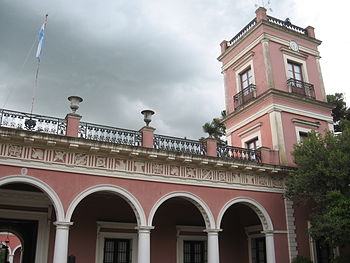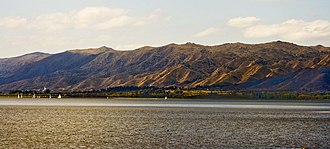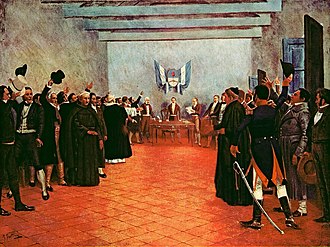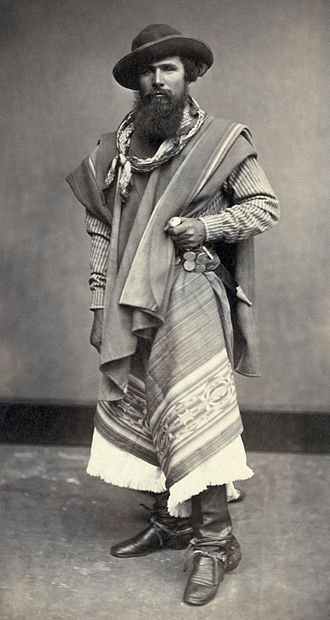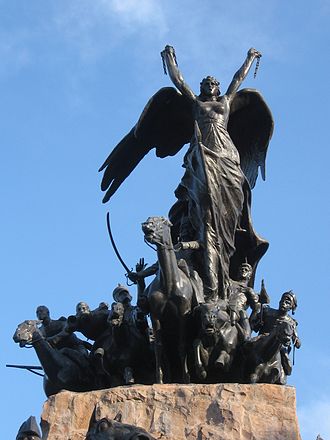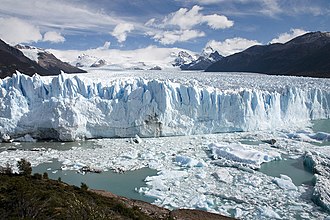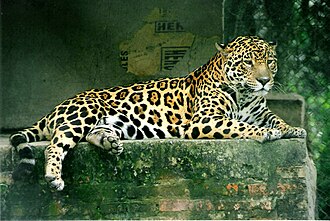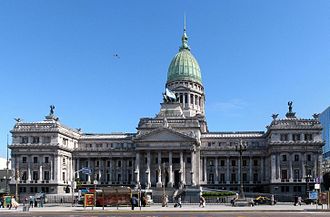Portal:Argentina/Selected picture
Selected picture 1
Portal:Argentina/Selected picture/1

La Boca is a neighborhood, or barrio of the Argentine capital, Buenos Aires. It retains a strong European flavour, with many of its early settlers being from the Italian city of Genoa. La Boca is a popular destination for tourists visiting Argentina, with its colourful houses and main street, the Caminito.
It is known throughout the sporting world as the home of Boca Juniors, one of South America's top football clubs.
Selected picture 2
Portal:Argentina/Selected picture/2

The Perito Moreno Glacier (50°29′S 73°03′W / 50.483°S 73.050°W) is a glacier located in the Los Glaciares National Park in the south west of Santa Cruz province, Argentina. It is one of the most important tourist attractions in the Argentine Patagonia.
The 250 km² ice formation, of 30 km in length, is one of 48 glaciers fed by the Southern Patagonian Ice Field located in the Andes system shared with Chile. This icefield is the world's third largest reserve of fresh water.
Selected picture 3
Portal:Argentina/Selected picture/3

In Argentina it is common to see people walking around the streets toting a mate and a thermos with hot water. In some parts of Argentina, gas stations sponsored by yerba mate producers provide free hot water to travellers, specifically for the purpose of drinking during the journey. There are disposable mate sets with a plastic mate and bombilla, and sets with a thermos flask and stacking containers for the yerba and sugar inside a fitted case.
Selected picture 4
Portal:Argentina/Selected picture/4

Selected picture 5
Portal:Argentina/Selected picture/5

Selected picture 6
Portal:Argentina/Selected picture/6

Selected picture 7
Portal:Argentina/Selected picture/7

Entrance to the Buenos Aires' underground station "Plaza Once" (line A)
Selected picture 8
Portal:Argentina/Selected picture/8

Selected picture 9
Portal:Argentina/Selected picture/9

The horneros, also known as ovenbirds are members of the genus Furnarius in the family Furnariidae, native to South America.
Selected picture 10
Portal:Argentina/Selected picture/10

Selected picture 11
Portal:Argentina/Selected picture/11

Selected picture 12
Portal:Argentina/Selected picture/12

Selected picture 13
Portal:Argentina/Selected picture/13

Selected picture 14
Portal:Argentina/Selected picture/14

Selected picture 15
Portal:Argentina/Selected picture/15

Selected picture 16
Selected picture 17
Selected picture 18
Portal:Argentina/Selected picture/18

Selected picture 19
Portal:Argentina/Selected picture/19

Selected picture 20
Portal:Argentina/Selected picture/20

Selected picture 21
Portal:Argentina/Selected picture/21

An Argentine Navy Dassault Super Etendard jet aircraft commences a "touch and go" landing, during flight operations aboard the Nimitz-class aircraft carrier USS Ronald Reagan (CVN 76). The Super Etendard is a carrier-based single-seat strike fighter first introduced into service in 1978. It is armed with two 30mm guns and can hold a variety of air-to-air weapons and air-to-ground munitions.
Selected picture 22
Portal:Argentina/Selected picture/22

A Penguin colony at Punta Tombo, Chubut Province.
Punta Tombo is a peninsula into the Atlantic Ocean 110 km (68 mi) south of Trelew in Southern Argentina, where there is an important colony of Magellanic Penguins.
Selected picture 23
Portal:Argentina/Selected picture/23

The Polish Glacier (Spanish Glaciar de los Polacos) is one of the glacial fields of Cerro Aconcagua, the highest peak in the Andes. It was named after a Polish expedition in 1934. Led by Konstanty Narkiewicz-Jodko, the team paved an alternative route to the peak, named the Polish Route, through the glacier.
Selected picture 24
Portal:Argentina/Selected picture/24

Chascomús railway station circa 1875 - from the Argentina National Archives
Selected picture 25
Portal:Argentina/Selected picture/25

A view of Rosario and the Paraná River from the top of the National Flag Memorial.
Selected picture 26
Portal:Argentina/Selected picture/26

Las Leñas is one of the largest Andean ski resorts in Argentina, together with Cerro Catedral in San Carlos de Bariloche, located in the western part of Mendoza Province. It is well known for its powder snow, good climate and excellent opportunities for extreme and off-piste skiing. Construction of the ski center began January 1983, and by July 1983 it opened with a hotel of 300 beds. The ski area has a good diversity of slopes ranging from very easy to extreme, including a good range of off-piste areas apt for extreme skiing. The skiable area base starts at an altitude of 2,240 m above mean sea level (7,350 feet) and goes up to 3,430 m (11,253 ft) for a total drop of 1,200 m (3,937 ft). The skiable surface amounts to 2.3 km2 (1 sq mi), with 27 runs and a maximum non-stop skiable distance of 7 km (4 mi) (not including off run alternatives). The total ski area reachable by land is the largest in South America.
Selected picture 27
Portal:Argentina/Selected picture/27

Pinamar is an Argentine coastal resort town located on the coast of the Atlantic Ocean in Buenos Aires Province.
Located less than 400 km (249 mi)south of Buenos Aires, it is one of several small seaside communities that line the coast. Since Pinamar's main attraction is the ocean, it is a fairly quiet town during the winter months. Tourism is what fuels the economy during the summer.
Selected picture 28
Portal:Argentina/Selected picture/28

The Paraná Delta is the delta of the Paraná River in Argentina. The Paraná flows north–south and becomes an alluvial basin (a flood plain) between the Argentine provinces of Entre Ríos and Santa Fe, then emptying into the Río de la Plata.
The Paraná Delta has an area of about 14,000 km2 (5,405 sq mi) and starts to form between the cities of Santa Fe and Rosario, where the river splits into several arms, creating a network of islands and wetlands. Most of it is located in the jurisdiction of Entre Ríos, and parts in the north of Buenos Aires.
Selected picture 29
Portal:Argentina/Selected picture/29

The Calchaquí Valleys (Spanish: Valles Calchaquíes) are a series of valleys in the northwestern region of Argentina which crosses the provinces of Catamarca, Tucumán and Salta. It is best known for its contrast of colours and its unique geography that ranges from the mountain desert to the subtropical forest.
Selected picture 30
Portal:Argentina/Selected picture/30

Main church in the town of Angastaco in San Carlos Department, Salta Province, Argentina, in the Calchaquí Valley.
Selected picture 31
Portal:Argentina/Selected picture/31

The Llao Llao Hotel is located in the tourist resort of San Carlos de Bariloche within the province of Río Negro, Argentina. This famous hotel is situated in the foothills of the Andes on a hill between the Moreno and Nahuel Huapi lakes.
Selected picture 32
Portal:Argentina/Selected picture/32

General Manuel Belgrano Bridge is an Argentine bridge over the Paraná River.
The General Manuel Belgrano Bridge spans the Paraná river and connects Corrientes and Chaco provinces in Argentina. This photo is taken from Corrientes city, and you can see a beach by Paraná river. The far big building is a silo in Barranqueras, Chaco province.
Selected picture 33
Portal:Argentina/Selected picture/33

Aerial view of Buenos Aires' Aeroparque Jorge Newbery airport (AEP/SABE). You can see, on the left side of the apron, the Boeing 757 Presidential aircraft.
Selected picture 34
Portal:Argentina/Selected picture/34

Spring at the Rosedal lake in Buenos Aires at the Tres de Febrero park in the Palermo neighborhood.
Selected picture 35
Portal:Argentina/Selected picture/35

The Estadio Monumental Antonio Vespucio Liberti, also known as El Monumental de Nuñez or River Plate Stadium, is a stadium in the Belgrano district of Buenos Aires, Argentina. It is the home venue of Club Atlético River Plate and is named after former club president Antonio Vespucio Liberti. El Monumental is considered to be the national stadium of Argentina.
The stadium was renamed after Antonio Vespucio Liberti on November 29, 1986.
Selected picture 36
Portal:Argentina/Selected picture/36
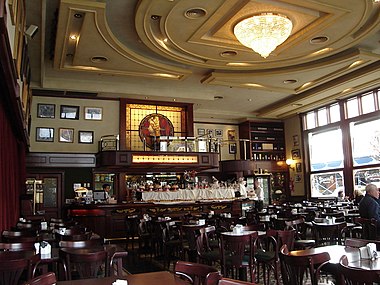
Iconic Café de los angelitos, long a meeting point for musical and literary talent in Balvanera, a neighborhood of Buenos Aires.
Selected picture 37
Portal:Argentina/Selected picture/37

Daguerrotype of the swearing in of the Buenos Aires Constitution at the la Plaza de la Victoria, (today Plaza de Mayo, 1854).
Selected picture 38
Portal:Argentina/Selected picture/38

The Andes are the world's longest continental mountain range. It is a continuous chain of highland along the western coast of South America. The range is over 7,000 km (4,300 mi) long, 200 km (120 mi) to 700 km (430 mi) wide (widest between 18° to 20°S latitude), and of an average height of about 4,000 m (13,000 ft), ending in Patagonia...
Selected picture 39
Portal:Argentina/Selected picture/39

Weather indicator at the Buenos Aires Botanical Gardens, designed by José Marcovich and donated by the Austro-Hungarian community of Buenos Aires (1910).
Selected picture 40
Selected picture 41
Selected picture 42
Selected picture 43
Selected picture 44
Portal:Argentina/Selected picture/44

Only protograph ever taken of José de San Martín, in his old age
Selected picture 45
Selected picture 46
Portal:Argentina/Selected picture/46
Selected picture 47
Portal:Argentina/Selected picture/47
Selected picture 48
Portal:Argentina/Selected picture/48
Selected picture 49
Portal:Argentina/Selected picture/49
Selected picture 50
Portal:Argentina/Selected picture/50
Selected picture 51
Portal:Argentina/Selected picture/51
Selected picture 52
Portal:Argentina/Selected picture/52
Selected picture 53
Portal:Argentina/Selected picture/53
Selected picture 54
Selected picture 55
Portal:Argentina/Selected picture/55
Selected picture 56
Portal:Argentina/Selected picture/56
Selected picture 57
Portal:Argentina/Selected picture/57
Selected picture 58
Selected picture 59
Portal:Argentina/Selected picture/59
Selected picture 60
Portal:Argentina/Selected picture/60
Selected picture 61
Selected picture 62
Portal:Argentina/Selected picture/62
Selected picture 63
Portal:Argentina/Selected picture/63
Selected picture 64
Portal:Argentina/Selected picture/64
Selected picture 65
Portal:Argentina/Selected picture/65
Selected picture 66
Portal:Argentina/Selected picture/66
Selected picture 67
Portal:Argentina/Selected picture/67
Selected picture 68
Portal:Argentina/Selected picture/68
Selected picture 69
Portal:Argentina/Selected picture/69
Selected picture 70
Portal:Argentina/Selected picture/70
Selected picture 71
Portal:Argentina/Selected picture/71
Selected picture 72
Portal:Argentina/Selected picture/72
Selected picture 73
Portal:Argentina/Selected picture/73

Credit: Colegio Salesiano Don Bosco de Ramos Mejía
Pope Francis, Jorge Mario Bergoglio by then, as a student (4th from left, middle row). He studied chemistry before joining the priesthood.
Selected picture 74
Portal:Argentina/Selected picture/74

Nelson Arrondo from Flickr
Vicentico, singer of Los Fabulosos Cadillacs and a solo career
Selected picture 75
Portal:Argentina/Selected picture/75

Credit: Rock Criollo
This is a poster of Silvio Marzolini during his time playing for Argentina national football team. He played for them between 1960 & 1969.








